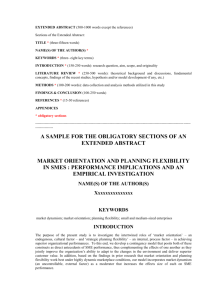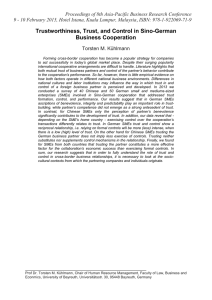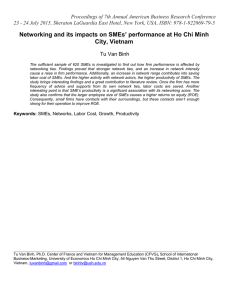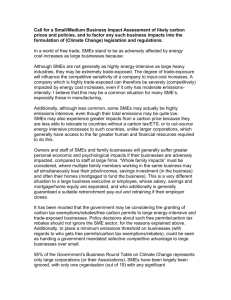Document 13724627
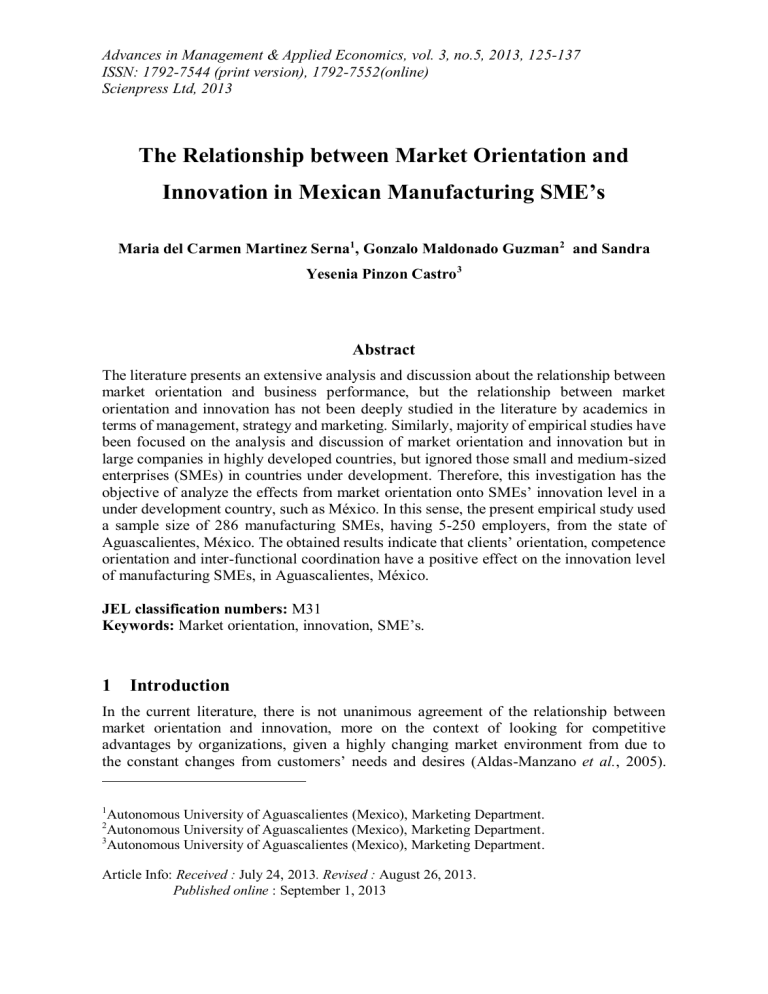
Advances in Management & Applied Economics, vol. 3, no.5, 2013, 125-137
ISSN: 1792-7544 (print version), 1792-7552(online)
Scienpress Ltd, 2013
The Relationship between Market Orientation and
Innovation in Mexican Manufacturing SME’s
Maria del Carmen Martinez Serna
1
, Gonzalo Maldonado Guzman
2
and Sandra
Yesenia Pinzon Castro
3
Abstract
The literature presents an extensive analysis and discussion about the relationship between market orientation and business performance, but the relationship between market orientation and innovation has not been deeply studied in the literature by academics in terms of management, strategy and marketing. Similarly, majority of empirical studies have been focused on the analysis and discussion of market orientation and innovation but in large companies in highly developed countries, but ignored those small and medium-sized enterprises (SMEs) in countries under development. Therefore, this investigation has the objective of analyze the effects from market orientation onto SMEs’ innovation level in a under development country, such as México. In this sense, the present empirical study used a sample size of 286 manufacturing SMEs, having 5-250 employers, from the state of
Aguascalientes, México. The obtained results indicate that clients’ orientation, competence orientation and inter-functional coordination have a positive effect on the innovation level of manufacturing SMEs, in Aguascalientes, México.
JEL classification numbers: M31
Keywords:
Market orientation, innovation, SME’s.
1 Introduction
In the current literature, there is not unanimous agreement of the relationship between market orientation and innovation, more on the context of looking for competitive advantages by organizations, given a highly changing market environment from due to the constant changes from customers’ needs and desires (Aldas-Manzano et al.
, 2005).
1
Autonomous University of Aguascalientes (Mexico), Marketing Department.
2
Autonomous University of Aguascalientes (Mexico), Marketing Department.
3
Autonomous University of Aguascalientes (Mexico), Marketing Department.
Article Info: Received : July 24, 2013 . Revised : August 26, 2013.
Published online : September 1, 2013
126 Maria del Carmen Martinez Serna
However, in the majority of previous research studies related to market orientation and innovation, using industry as a unit of analysis, some studies have focused on relating both concepts at an industry level. Also, obtained results from the analysis made in those studies have been positive and negative, depending on the level of innovation on the industries analyzed (Verhees and Meulenberg, 2004; Low, et al.
, 2007).
On one hand, the relationship between market orientation and firms have been analyzed in the field of marketing and discussed in a consistent manner, overall focusing on the identification and satisfaction of customers’ needs and the business performance (Kirca et al.
, 2005; Ellis, 2006). Though, the relationship between market orientation and innovation is limited, above all in the inconsistencies shown in the literature about the independent and interrelated effects performed by two central pillars of market orientation
(customer and competence orientation) within innovation activities (Lukas and Ferrell,
2000; Frambach et al.
, 2003; Grinstein, 2008). Likewise, there is an important debate, in the literature, about the effects over the 3 rd
component of market orientation (functional coordination) in the innovation (Henard and Szymanski, 2001).
In this sense, the current literature does not show any certainty about the effects between market orientation and innovation in various environments and organizational contexts
(Gatignon and Xuereb, 1997; Grinstein, 2008). Consequently, it is important to analyze in more detail the influence between market orientation and innovation in companies (Slater and Narver, 1995; Sinkula and Baker, 1999; Farrell and Oczkowiski, 2002); there are studies that indicate that there is a high correlation between these constructs (Hurley and
Hult, 1998; Calantone et al.
, 2002; Aldas-Manzano et al.
, 2005; Keskin, 2006; Low et al.
,
2007; Grinstein, 2008).
On the other hand, most of the empirical studies, presented on the current literature about the relationships between market orientation and innovation, have been focused on large companies of highly developed countries, ignoring small and medium-sized enterprises
(SMEs) in general, and more in countries under development. For that reason, in accordance with Keskin (2006), who investigates about the effects of market orientation and innovation in SMEs, in countries under development, contributes to knowledge literature in three main ways.
The first one, is that in the majority of papers carried out, in United States and United
Kingdom, using mainly Narver and Slater (1990) scales, Kohli et al.
(1993) and
Calantone et al.
(2002), who indicate that these scales have high feasibility and reliability indexes, and that it can be applied on a context of SMEs in a country under development, such as Mexico.
The second one, is that the relation between market and innovation in SMEs possibly generate different results from those obtained in large companies, principally because
SMEs are less formal, structured and sequential (Peterson, 1988; Meziou, 1991; Gibb,
1997; Anderson and Boocock, 2002), and commonly they do not research market and do not have long-term market planning (Peterson, 1988; Meziou, 1991; Blankson and Stokes,
202).
Finally, the last reason is that a greater number of the studies relating market orientation and innovation of SMEs, have been fragmented or uncompleted, which requires empirical studies that relate these two constructs in an integrating model applied to SMEs.
Therefore, an additional contribution of this study, apart from applying it in SMEs in a country under development, like México, is the application of a methodology which is different from previous studies and consistent in testing the theoretical model relating these variables through a structural equations model.
Market Orientation and Innovation in Mexican Manufacturing SME’s 127
2 Literature Review
Market orientation is a topic widely analyzed and debated in the current literature of marketing since 1990 decade, when Kohli and Jaworski (1990) used for the first time the term market orientation (Keskin, 2006), but it is until the past decade when studies increased, and contributions from Kohli and Jaworski (1990) and Narver and Slater (1990) take greater importance among research in the marketing field (Aldas-Manzano et al.
,
2005). Hence, in general terms, the literature defines a market orientation as a group of processes and behaviors (Kohli and Jaworski, 1990) or like a group of cultural aspects
(Narver and Slater, 1990) with the aim to create superior value for customers.
In this sense, Kohli and Jaworski (1990) used the market orientation term to refer the marketing concept, through intelligence generation, intelligence dissemination and responsibility (implementation of a marketing strategy) (Keskin, 2006). Therefore, Kohli and Jaworski (1990) are based on three basic pillars of marketing (customers focus, marketing coordination and profit) and covers three basic activities: 1) integration of market information related to customers; 2) the dissemination of market information inside enterprises; and 3) design and implementation of an answer to such information
(Aldas-Manzano et al.
, 2005).
Narver and Slater (1990) considered that market orientation in an organizational culture integrates three essential behavior components: customer orientation, competence orientation and inter-functional coordination. Also, these authors emphasize on these three components, which can integrate the generation and dissemination of market information and the answer to manage this information (Aldas-Manzano et al.
, 2005).
Therefore, in general terms it is possible to consider both contributions, from the model of
Kohli and Jaworski (1990), and the model of Narver y Slater (1990), which are complementary and non-mutually exclusionary.
This way, the proposed models by Kohli and Jaworski (1990) and Narver and Slater
(1990) have served as a base to all majority of research made about market orientation
(Grinstein, 2008). As a result, this paper considers the model proposed by Narver and
Slater (1990) because various authors consider that its three components ( customer orientation, competence orientation and inter-functional coordination) are important to provide a holistic perspective about the ability that companies have to collect and to use information about marketing in an effective and efficient manner (Narver and Slater, 1990;
Jaworski and Kohli, 1993; Grinstein, 2008).
On the other hand, traditionally in the literature it is possible to identify a positive relationship between market orientation and innovation, because early 1990 decade Kohli and Jaworski (1990), Deshpandé et al.
(1993), Jaworski and Kohli (1993) and Slater and
Narver (1994a, b; 1995) have considered that market orientation allow companies to obtain higher degrees of innovation and success in commercialization of new products. At the same time, Atuahene-Gima (1995) found besides of a positive relationship between market orientation and the innovation of new products that the market orientation allow significantly to increase new products profitability. In a study carried out a year after,
Atuahene-Gima (1996) concluded that the market orientation decisively impacts profitability from new products and services profitability.
Similarly, Santos and Vazquez (1997), in their study on high technology firms in Spain, concluded that market orientation strongly influences both innovation and commercialization activities from innovations achieved in the company. Whereas, Han et al.
(1998) shown that both market orientation and its different components have a strong
128 Maria del Carmen Martinez Serna positive relationship on technology innovation and innovation on enterprises organization.
At the same time, these authors considered that innovations in technology and management allow to significantly improving profitability levels or company benefits.
In this sense, Lado et al.
(1998) on his study made on the financial sector in Spain, concluded that the market orientation positively impacts innovation levels, however, they did not find a direct relationship between the market orientation and the innovations profitability, but companies obtain better profits according to the level of involvement they have in developing new products. Meanwhile, Lukas and Ferrell (2000) in their research on U.S. industry, they found that innovation in developing new products proportionally varies in the way companies get involved in market orientation.
Accordingly, Lukas and Ferrell (2000) state that customer orientation increase commercialization of new products, that competence orientation reduces the extension of existing products line and of new products, and that inter-functional coordination widen commercialization of products extensions. Therefore, in general terms these authors found a positive relationship between market orientation and the innovation of new products. In conclusion and considering the papers, Lado and Maydeu-Olivares (2001),
Aldas-Manzano et al.
(2005), Keskin (2006), Low et al.
(2005; 2007) and Grinstein
(2008), the market orientation strongly influence innovation. The more a company gets involved in market orientation higher the level of innovation.
On the other hand, the debate about the effect of customer orientation in the innovation activities has been strong but it has not achieved an agreement point (Lukas and Ferrell,
2000; Christensen et al.
, 2005), because commonly in marketing literature the customer orientation has been considered as a way to increase the innovation level, as a response to market conditions (Jaworski and Kohli, 1993). Hence, SMEs that have adopted a customer orientation commonly use more information and knowledge about customers´ needs in order to increment their innovation level (Atuahene-Gima, 1995, 2005; Narver et al.
, 2004). Simultaneously, various authors have considered that customer orientation is an essential resource to increase the innovation level, because generally customers have difficulties to articulate their needs further than their consuming experiences (Christensen,
1997; Christensen et al.
, 2005). For these reasons, the following hypothesis can be formulated:
H
1
: The higher level of customer orientation, higher level of innovation
According to the debate about the effects from competence orientation on the innovation level, there has not been an agreement point in the literature (Lukas and Ferrell, 2000), because some studies suggest that firms that have implemented customer orientation have taken advantage from market opportunities to create products and marketing programs, which have differentiated them from their competitors (Im and Workman, 2004), or it has allowed them to position themselves on an attractive second place (Frambach et al.
, 2003).
At the same time, some researchers consider that the competence orientation is an essential resource for imitation of products, which can generate negative results in the innovation activities (Lukas and Ferrell, 2000). However, various authors suggest that the effects from competence orientation are more positive than negative (Grinstein, 2008).
Consequently, according to such information it is possible to establish the following hypothesis:
H
2
: The higher level of competence orientation, higher level of innovation
Finally, the inter-functional coordination reflects the interaction level and communication that exists in an organization (Im and Workman, 2004), so the majority of researcher on the marketing field consider that this has a positive effect in the innovation level, because
Market Orientation and Innovation in Mexican Manufacturing SME’s 129 the inter-functional coordination make easier the dissemination of market information and problem solving (Gatignon and Xuereb, 1997). Nevertheless, a high level of collaboration and information interchange can generate negative effects in the innovation activities firms (Henrad and Szymanski, 2001). Thus, firms that implement an inter-functional coordination should only interchange the necessary market information to develop new products (Im and Workman, 2004), to avoid negative effects in their innovation level. In this sense, the positive effects from the inter-functional coordination exceed on the innovation level.
H
3
: The higher level of inter-functional coordination, higher level of innovation
Figure 1 shows with details the established hypothesis about the relationship between market orientation and the innovation activities.
Figure 1: Theoretical model
Source: Authors
3 Methodology
To respond the established hypotheses in the proposed theoretical model, an empirical research was carried out in manufacturing SMEs in the Aguascalientes state, in Mexico.
A companies’ directory was used, which is provided by the Organizations Information
System of Mexico (SIEM by its Spanish acronym), which has registered 7,121 firms in the Aguascalientes state, on August 30 th
2010. At the same time, for this study only manufacturing companies have been considered, those that have 5 to 250 employees’, so the firms’ directory from SIEM was reduced to 1,122 firms. Therefore, such companies’ directory was considered for sample selection, which was selected by a random sampling with a maximum error of ±5% and a confidence interval of 95%, from which the result was 286 firms. Data was collected through delivered to managers, from which 244 surveys were received, 85% response rate.
130 Maria del Carmen Martinez Serna
In order to measure market orientation the Narver and Slater (1990) scale was used, who measured it by three essential factors: customers’ orientation
, measured by a 9 items scale, competence orientation measured in a 5 items scale; and, inter-functional coordination was measure with a 6 items scale. Also, to measure innovation the Oslo Manual (OECD,
2005) was used, which considers that innovation can be measured by four basic factors: products innovation , measured by 4 items, process innovation , measured by 5 items scale, marketing innovation , measured with a 9 items scale, and management innovation , measured with a 9 items scale (Pinzon, 2009). All items from these variables are constructed according to Likert scale with 7 levels, with limits: 1= totally disagree and 7= totally agree.
Before the analysis results from this paper, it was carried out a validity and reliability analysis of used scales in the theoretical model, applying a Confirmatory Factor Analysis
(CFA) and using the maximum likelihood method with the EQS software (Bentler, 2005;
Brown, 2006; Byrne, 2006). At the same time, the Cronbach’s alpha and the Composite
Reliability Index (CRI) were used to measure the scales’ reliability (Bagozzi and Yi,
1988), which shown strong evidence of internal reliability in the used scales (Nunally and
Bernstein, 1994; Hair et al.
, 1995). In table 1 the CFA are shown, which indicate a good data fit ( S-BX 2 = 1,496.406; df = 928; p = 0.000; NFI = 0.980; NNFI = 0.992; CFI = 0.992; and RMSEA = 0.050), all items are significant from the related factors (p < 0.01) and the standardized factor weights are greater than 0.60 (Bagozzi and Yi, 1988), which indicate that exist sufficient evidence of discriminant validity.
Table 1: Internal consistence and convergent validity evidence of the theoretical model
Variable
Customer Orientation
Competence
Orientation
Inter-functional
Orientation
Indicator
ACL2
ACL4
ACL5
ACL6
ACL7
ACL8
ACL9
ACO1
ACO2
ACO3
ACO4
ACO5
CIF1
CIF2
CIF3
CIF4
CIF5
CIF6
Factor
Loading
0.754***
0.846***
0.740***
0.794***
0.796***
0.854***
0.773***
0.818***
0.892***
0.914***
0.851***
0.605***
0.736***
0.861***
0.755***
0.825***
0.798***
0.740***
33.192
33.691
30.897
14.186
1.000
a
22.392
19.094
21.562
20.717
20.087
Robust t-Value
1.000
a
24.336
14.741
22.317
22.431
24.293
21.368
1.000
a
Average Factor
Loading
0.794
0.816
0.786
Cronbach´s
Alpha
0.921
0.910
0.909
CRI EVI
0.923 0.632
0.912 0.678
0.907 0.679
INP1
INR2
0.810***
0.872***
10.477
11.200 innovation 0.902 0.937 0.947 0.818
INM3 0.941*** 12.489
ING4 0.985*** 14.639
S-BX
2
(df = 928) = 1,496.406; p < 0.000; NFI = 0.980; NNFI = 0.992; CFI = 0.992; RMSEA =
0.050 a
= Parameters constrained to the value in the identification process
*** = p < 0.01
Market Orientation and Innovation in Mexican Manufacturing SME’s 131
Table 1 show that the Cronbach’s alpha and the CRI exceed 0.70 as recommended by
Nunnally and Bernstein (1994) and Bagozzi and Yi (1988), and the Extracted Variance
Index (EVI) is greater than 0.50 suggested by Fornell and Larcker (1981). Also, in terms of measuring discriminant validity two tests are carried out, which can be seen in Table 2.
The Anderson and Gerbing (1988) confidence interval is presented in the matrix; this indicates that with a confidence interval of 95% none of the latent factors of the correlation matrix has a value of 1.0. The extracted variance test by Fornell and Larcker
(1981) indicates that EVI is superior to ever pair of constructs. Therefore, it can be concluded that the different measurements made in this paper indicate that there is enough convergent and discriminant validity and reliability.
Table 2: Discriminant validity measuring of the theoretical model
Variables
Customer
Orientation
Competence
Orientation
Inter-functional
Orientation
Innovation
Customer Orientation
Competence
Orientation
Inter-functional orientation
0.632
0.425 - 0.565
0.376 - 0.520
0.245
0.678
0.381 - 0.521
0.200
0.203
0.679
0.235
0.209
0.199
Innovation 0.411 - 0.559 0.401 - 0.513 0.386 - 0.506 0.818
The diagonal represents the Extracted Variance Index (EVI), whereas above the diagonal part presents the Variance (the correlation squared). Below the diagonal, it is shown the correlation estimation of the factors with a confidence interval of 95%.
4 Results
In order to make sure that the theoretical model structure and to contrast the established hypotheses in this paper, a structural equations model (SEM) using the EQS 6.1 software
(Bentler, 2005; Byrne, 2006; Brown, 2006), in which the nomological validity was analyzed through a chi-squared comparing the theoretical model with the measurement model (Anderson and Gerbing, 1988; Hatcher, 1994), finding significant evidence between them. The results from this analysis are shown in detail in Table 3.
132 Maria del Carmen Martinez Serna
Hypothesis
Table 3: SEM results from the theoretical model
Path
Standardized path coefficients
Robust t-Value
H
1
: The higher level of customer orientation, higher level of innovation.
Customer O. → Innovation 0.414*** 5.034
H
2
: The higher level of competence orientation, higher level of innovation.
Competence O. → Innovation 0.335*** 4.555
H
3
: The higher level of inter-functional orientation, higher level of innovation.
Inter-functio. O. → Innovation 0.292*** 4.120
S-BX
2
(df = 924) = 1,470.848; p < 0.000; NFI = 0.890; NNFI = 0.908; CFI = 0.9142; RMSEA
= 0.049
*** = P < 0.01
Concerning hypothesis H
1
, the results (β = 0.414, p < 0.01) indicate that the customer orientation have significantly positive effects on the innovation level of manufacturing
SMEs in Aguascalientes, which demonstrate that SMEs are currently implementing a number of company strategies to focus efforts and activities to customers. In other words, all organization is focused on improve attention and service to customers, independently of a particular department’s responsibility, which can generate greater customers satisfaction and as a result an increment on its loyalty.
With regards to hypothesis H
2
, the results (β = 0.335, p < 0.01) demonstrate that competence orientation have significantly positive effects on the innovation level of manufacturing SMEs in Aguascalientes, which indicates that a relevant number of manufacturing SMEs carry out activities related to gathering information of both products and services offered by the competence such as advertising and promotions strategies set on the market, which can also allow SMEs to go further than their competence in the introduction of new products and services in the market.
Lastly, the results from hypothesis H
3
(β = 0.292, p < 0.01) shows that the inter-functional coordination also have significantly positive effects on the innovation level on manufacturing SMEs. This result allows inferring that in the majority of manufacturing
SMEs in Aguascalientes there is a wide collaboration and coordination among various departments of the organization. This is not only by sharing customers’ information but also that related to competence activities, which allows aligning the departments’ objectives and designing and implementing more effective business strategy.
In conclusion, through this paper it is possible to prove that the three constructs integrating the market orientation have significant effects, which contributes with sufficient empirical evidence that demonstrate that the market orientation has a close relationship with innovation of manufacturing SMEs.
Market Orientation and Innovation in Mexican Manufacturing SME’s 133
5 Conclusion
The majority of research made on business management has been developed on large companies and developed countries, however, SMEs’ studies have been neglected, even though these have a strong impact on employment, innovation and economical and social growth in those countries (Lin, 1998); even more these kind of studies have not been consider in countries under development. Therefore, with the aim to increment discussion, analysis, practice and methodology of business management among researchers, academics and professionals, this paper provides empirical evidence about the close relationship between market orientation and innovation in SMEs of a country under development, such as México, which allows three main conclusions as follows.
Firstly, the results of this study demonstrate that there is a wide number of manufacturing
SMEs that have adopted activities with customers’ orientation as a business strategy have improved its innovation in products, processes, marketing and management systems.
Similarly, SMEs frequently collect information related to current customers’ preferences and tastes, in a way that this information allow enterprises to improve their quality, also, to adjust and change their products and services required by them, which can generate, apart from a greater loyalty and customer satisfaction, an increment of their growth, financial and competitiveness performance of manufacturing SMEs.
Secondly, manufacturing SMEs in Aguascalientes have a daily activity of collecting information about their competence, albeit lower than the collected information about customers, but equally important to improve the innovation level. Therefore, the competence orientation strategy allows SMEs knowing not only objectives and strategies from their main competitors but to identify threats from their competence’s products and services, which can be their substitutes that provides SMEs an opportunity to change and adjust their products and services to differentiate them from competence, or to implement a number of promotional or advertising aiming to position their products and services among the actual and future customers.
Thirdly, manufacturing SMEs are also making adjustments and changes within organization, with the aim to improve communication and participation among departments or functional areas, which has allowed them to adopt the inter-functional coordination strategy. This strategy requires that apart from marketing strategies to be developed in parallel with other functional areas of the enterprise, thus efforts made are rewarded with customers’ satisfaction.
On the other hand, these results have implications to managers from these manufacturing
SMEs in Aguascalientes. Among them, improvement of the innovation level on products and processes, such as, marketing and management systems. Enterprises have to adopt and implement a market orientation strategy; this means that all functional areas of the organization have to align their objectives to significantly improve the customers’ satisfaction level. Therefore, managers should focus their efforts to a more customer orientated, looking for better relationships with customers and suppliers, to widen the market share in the future.
Additionally, a strategy implementation represents an additional effort by SMEs’ managers, because, on one side they have to train workers and employers in the use of information technologies, to provide a better product and services to customers. For that, it is necessary to have precise information about tastes and preferences. Besides, managers should get involved in understanding the market orientation, looking for a
134 Maria del Carmen Martinez Serna formal or informal courses updating, in a way that managers adapt these types of enterprise strategies to the organization needs and resources.
To finish, manufacturing SMEs’ managers should adopt strategies to gather information about their main competitors, because this type of information is fundamental if changes and improvements to products and services is aimed to be improved, a higher level of satisfaction is pursued, or to survive in a globalized and competitive market, where SMEs are living now. Consequently, managers should understand their main competitors, so their products and services offered to market and establish weaknesses and strengths from their products and services compared to competence, with the aim of developing actions that allow a differentiation of their products and services and acceptance among their customers and suppliers.
At the same time, this study has a number of limitations. First of all, for the sample used enterprises with 5 to 250 employees were considered leaving out those with 5 employees or less, which represent 60% of the population. For future studies, it is recommended to consider micro, small and medium-sized enterprises in order to analyze the information behavior. Another limitation was the process for information collection, because it was considered only a part of market orientation and innovation, an important part of interviewed SMEs considered some information as confidential, so it is possible that provided data does not reflect enterprises reality.
Another limitation is that this survey was carried out only on SMEs managers, because it was considered that they have good knowledge of market orientation and innovation activities in the organization. In future studies it would be recommended that this instrument be applied to all employees and customers of the companies, in order to obtain additional information that allows comparing enterprise information with customers’ information. Similarly, another limitation was the use of measurement scales for market orientation and innovation, because qualitative variables were only used. In future studies it would be advisable to use quantitative variables in order to establish the possibility of similar results.
Finally, it is important to go further with results and to discuss future studies, what could be the effect of innovation if another scale was used to measure market orientation? What could be the effects on SMEs if more quantitative scales were used to measure market orientation and innovation? On what types of innovation the market orientation has more impact in manufacturing SMEs? These and other questions that could be developed through this research work can be answered in future research.
References
[1] J. Aldas-Manzano, I. Küster and N. Vila, Market orientation and innovation: an inter-relationship analysis, European Journal of Innovation Management, 8 (4),
(2005), 437-452.
[2] J. Anderson and D. Gerbing, Structural equation modeling in practice: a review and recommended two-step approach, Psychological Bulletin , 13 , (1988), 411-423.
[3] V. Anderson and G. Boocock, Small firms and internationalization: learning to manage and managing to learn, Human Resource Management Journal , 12 , (2002),
5-24.
[4] K. Atuahene-Gima, An exploratory analysis of the impact of market orientation of new product performance: a contingency approach, Journal of Product Innovation
Market Orientation and Innovation in Mexican Manufacturing SME’s 135
Management , 12 (4), (1995), 275-293.
[5] K. Atuahene-Gima, Market orientation and innovation, Journal of Business
Research , 35 (2), (1996), 93-103.
[6] K. Atuahene-Gima, Resolving the capability-rigidity paradox in new product innovation, Journal of Product Innovation Management , 12 , (2005), 275-293.
[7] R.P. Bagozzi and Y. Yi, On the evaluation of structural equation models, Journal of the Academy of Marketing Science , 16 (1), (1988), 74-94.
[8] P. Bentler, EQS 6 Structural Equations Program Manual , Multivariate Software,
California, 2005.
[9] C. Blankson and D. Stokes, Marketing practices in the UK small business sector,
Marketing Intelligence & Planning , 20 , (2002), 49-61.
[10] T. Brown, Confirmatory Factor Analysis for Applied Research , New York: The
Guilford Press, New York, 2006.
[11] B. Byrne, Structural Equation Modeling with EQS, basic concepts, applications, and programming , LEA Publishers, London, 2006.
[12] R.J. Calantone, S.T. Cavusgil and Y, Zhao, Learning orientation, firm innovation capability and firm performance, Industrial Marketing Management , 31 , (2002),
515-524.
[13] C. Christensen, The Innovator’s Dilemma , Harvard Business School Press, Boston,
1997.
[14] C. Christensen, S. Cook and T. Hall, Marketing malpractice, Harvard Business
Review , 12 , (2005), 74-83.
[15] R. Deshpandé, J. U. Farley and F.E. Webster, Corporate culture, client orientation and innovations in Japanese firms: A quadrad analysis, Journal of Marketing , 57 (1),
(1993), 23-37.
[16] P. Ellis, Market orientation and performance: a meta-analysis and cross-national comparisons, Journal of Management Studies , 43 (5), (2006), 1089-1107.
[17] M.A. Farrell and E. Oczkowski, Are market orientation and learning orientation necessary for superior organizational performance?, Journal of Market Focused
Management , 5 , (2002), 197-217.
[18] C. Fornell and D. Larcker, Evaluating structural equation models with unobservable variables and measurement error, Journal of Marketing Research , 18 , (1981), 39-50.
[19] R. Frambach, J. Prabhu and T. Verhallen, The influence of business strategy on new product activity: the role of market orientation, International Journal of Research in
Marketing , 20 , (2003), 377-397.
[20] H. Gatignon and J.M. Xuereb, Strategic orientation of the firm and new product performance, Journal of Marketing Research , 34 (2), (1997), 77-90.
[21] A.A. Gibb, Small firms’ training and competitiveness: building upon the small business as a learning organization, International Small Business Journal , 15 ,
(1997), 13-29.
[22] A. Grinstein, The effect of market orientation and its components on innovation consequences: a meta-analysis, Journal of the Academic of Marketing Science , 36 ,
(2008), 166-173.
[23] J.F. Hair, R.E. Anderson, R.L. Tatham and W.C. Black, Multivariate Data Analysis with Readings, Prentice-Hall, New York, 1995.
[24] J.K. Han, N. Kim and R.K. Sirvastava, Market orientation and organizational performance: is innovation missing link?, Journal of Marketing , 62 (4), (1998),
30-45.
136 Maria del Carmen Martinez Serna
[25] L. Hatcher, A Step by Step Approach to Using the SAS System for Factor Analysis and Structural Equation Modeling , SAS Institute Inc, North Carolina, 1994.
[26] D. Henard and D. Szymanski, Why some new products are more successful than others, Journal of Marketing Research , 38 (8), (2001), 362-375.
[27] F.B. Hurley and G.T.M. Hult, Innovation, market orientation and organizational learning: an integration and empirical examination, Journal of Marketing , 62 , (1998),
42-54.
[28] S. Im and J. Workman, Market orientation, creativity and new product performance in high-technology firms, Journal of Marketing , 68 (4), (2004), 114-132.
[29] B.J. Jaworski and A.K. Kohli, Market orientation: antecedents and consequences,
Journal of Marketing , 57 (3), (1993), 53-70.
[30] H. Keskin, Market orientation, learning orientation and innovation capabilities in
SMEs: an extended model, European Journal of Innovation Management , 9 (4),
(2006), 396-417.
[31] A. Kirca, S. Jayachandran and W. Bearden, Market orientation: a meta-analytic review and assessment of its antecedents and impact on performance, Journal of
Marketing , 69 , (2005), 24-41.
[32] A.K. Kohli and B.J. Jaworski, Market orientation: the construct, research propositions and managerial implications, Journal of Marketing , 54 , (1990), 1-18.
[33] A.K. Kohli, B.J. Jaworski and A. Kumar, MARKOR: a measure of market orientation, Journal of Marketing Research , 30 , (1993), 467-477.
[34] N. Lado and A. Maydeu-Olivares, Exploring the link between market orientation and innovation in the European and US insurance markets, International Marketing
Review , 18 (2), (2001), 130-145.
[35] N. Lado, M.A. Martinez and A. Maydeu-Olivares, Market orientation and innovation in service enterprises: some empirical results from the insurance business,
Proceedings of the IFSAM World Congress . Alcala de Henares, 7, 1998, 98-115.
[36] D.R. Low, R.L. Chapman and T.R. Sloan, Inter-relationship between innovation and market orientation in SMEs, Management Research News , 30 (12), (2007), 878-891.
[37] B.A. Lukas and O.C. Ferrell, The effect of market orientation on product innovation,
Journal of the Academy of Marketing Science , 28 (2), (2000), 239-247.
[38] F. Meziou, Areas of strength and weakness in the adoption of the marketing concept by small manufacturing firms, International Small Business Journal , 29 , (1991),
72-78.
[39] J.C. Narver and S.F. Slater, The effect of a market orientation on business profitability , Journal of Marketing , 54 , (1990), 20-35.
[40] J.C. Narver, S.F. Slater and D. MacLachlan, Responsive and proactive market orientation and new product success, Journal of Product Innovation Management ,
21 (5), (2004), 334-344.
[41] J.C. Nunnally and I.H. Bernstein, Psychometric Theory , McGraw-Hill, New York,
1994.
[42] OCDE, Oslo Manual: The Measurement of Scientific and Technological Activities.
Proposes Guidelines for Collecting and Interpreting Innovation Data, Paris, 2005.
[43] R.T. Peterson, An analysis of new product ideas in small business, Journal of Small
Business Management , 26 , (1988), 25-31.
[44] C.S.Y. Pinzón, Impacto de la Orientación a Mercado en la Innovación en Empresas de Aguascalientes. Tesis Doctoral, Universidad Autónoma de San Luis Potosí ,
Mexico, 2009.
Market Orientation and Innovation in Mexican Manufacturing SME’s 137
[45] R.W. Ruekert, Developing a market orientation: an organizational strategy perspective, International Journal of Research in Marketing , 9 , (1992), 224-245.
[46] M.L. Santos and R. Vázquez, La estrategia marketing como instrumento competitivo en las empresas de alta tecnología, Revista Asturiana de Economía , 9 ,
(1997), 46-55.
[47] J.M. Sinkula and W.E. Baker, Learning orientation, market orientation and innovation: integrating and extending models of organizational performance,
Journal of Market Focused Management , 4 , (1999), 295-308.
[48] S.F. Slater and J.C. Narver, Does competitive environment moderate the market orientation-performance relationship?, Journal of Marketing , 58 (1), (1994a), 46-55.
[49] S.F. Slater and J.C. Narver, Market orientation, client value and superior performance, Business Horizons , 37 (2), (1994b), 22-28.
[50] S.F. Slater and J.C. Narver, Market orientation and the learning organization,
Journal of Marketing , 59 , (1995), 63-74.
[51] J.H.M. Verhees and M.T.G. Meulenberg, Market orientation, innovativeness, product innovation and performance in small firms, Journal of Small Business
Management , 42 (2), (2004), 134-155.
